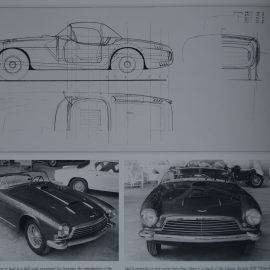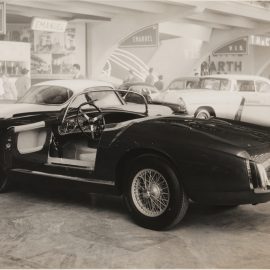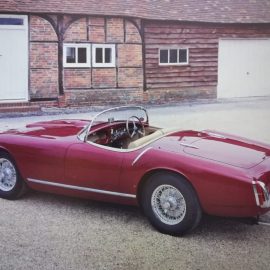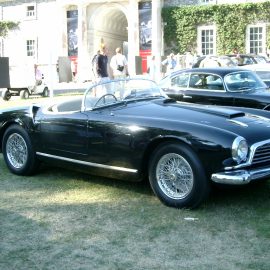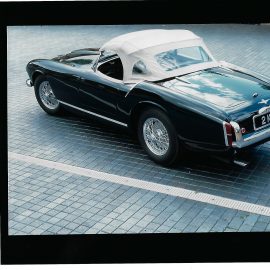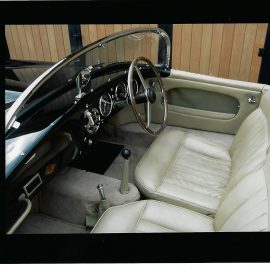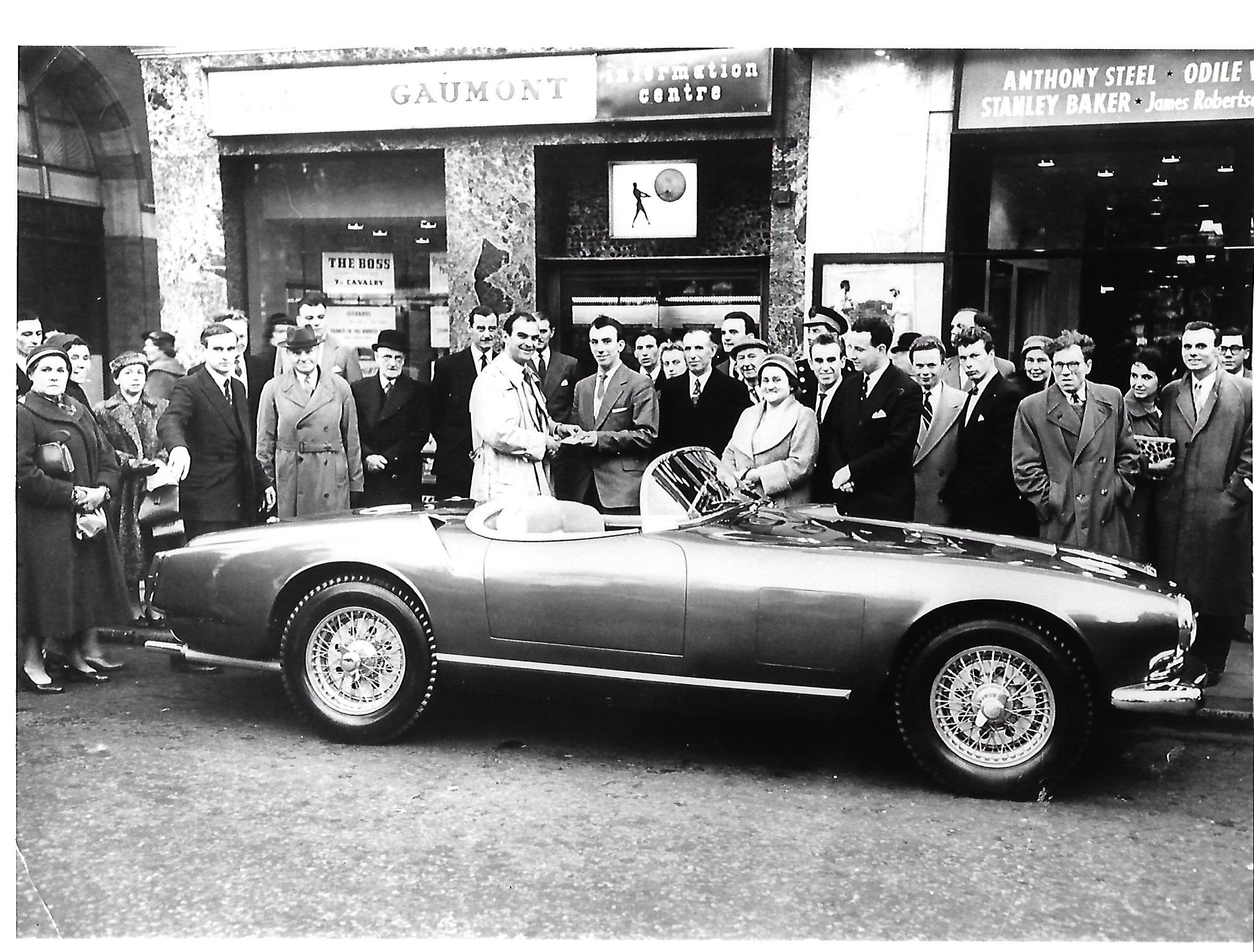
28 Jun Touring Spyders
Part 1 of a three part story behind a trio of Aston Martin DB2/4 Mk.IIs that were sent to Carrozzeria Touring of Milan in 1955 to be fitted with some distinctive and innovative Superleggera bodywork. One of these rare cars is part of the FMM collection, but first a look at how it all started…
Before James Bond, post-war Aston Martins were primarily expensive grand touring cars described as ‘British cultural icons’. The company was founded in 1913, but the first car was effectively still-born due to the outbreak of WW1 and it was not until a new car appeared in 1920 that Aston Martin’s history began. But the company always struggled financially and was subjected to a number of takeovers prior to WW2. Then in 1947 it was bought by industrialist – and tractor manufacturer – David Brown, and business started to improve. The DB line of cars began to emerge, and in an effort to reach new markets Brown looked at new ways to promote the brand, including sending bare chassis to various coachbuilders to create distinctive design concepts. One such recipient was Carrozzeria Touring of Milan, which in 1955 received three DB2/4 Mk.II chassis with which to apply its innovative and patented Superleggera body construction. And here begins a fascinating tale…
The three chassis were numbered AM300/1161, AM300/1162 and AM300/1163. Simply put, Superleggera construction involves attaching lightweight aluminium panels over a strong framework made up of thin-diameter steel tubing. Pre-WWII, the process had already been successfully utilised by prominent manufacturers including Alfa Romeo, BMW, Fiat and Isotta-Fraschini before the likes of Ferrari and Lamborghini became customers after the war. But who would have guessed that Brown’s initiative with Touring would lead to a decades-old association between the two companies, which still exists today with the DBS Superleggera? But that is another story…
Production of the DB2/4 began in 1953 and the Mk.II was introduced in 1955. It is not clear when the trio of bare chassis were actually sent to Touring, but the three must have been some of the earliest Mk.IIs to be produced. Brown’s brief to the carrozzeria was to develop a two-seater roadster more dramatic-looking than Aston’s own drophead, and the responsibility for design was entrusted to Touring’s talented chief designer, Federico Formenti.
One of Formenti’s layout drawings shows that he spent a total of 24 hours between 24 and 28 November putting his design together. Touring was being run at this time by Carlo Felice Bianchi ‘Cici’ Anderloni, son of the company’s co-founder Felice Bianchi Anderloni. Cici described the barchetta (a term used by Italian car manufacturers for a two-seat sports car with either an open top or convertible roof design) proposal as “typical of the work of Formenti when he was given more freedom than usual, and it reconciles a very severe baseline with some more extravagant touches like the false air vents, sharp at the edge and not very pleasing to the eye, at the top of the rear mudguards”. Apart from these vents, the stylised full-width grille, elegant bumpers, twin bonnet air scoops, curvaceous windscreen, and subtly-finned rear mudguards housing vertical tail-lights are just some of the car’s distinctive design elements. The leather-stitched interior was a natural for Italian-designed exotics of the time. Suggestions have been made that styling influences were taken from other cars designed by Pinin Farina, Nuccio Bertone, Giovanni Michelotti and Franco Scaglione, but these are not substantiated.
Chassis 1161 was the first car to be fitted with the curvaceous new bodywork (body number 4343) and, painted black, it made its debut at the 1956 Turin Motor Show held from April 21 to May 2. And rather than using the barchetta moniker, Touring opted for Spyder, the generic term for an open-topped sports car, or roadster.
After the show, the car was serviced at Aston Martin on 5 June 1956 and sent back to Italy in chassis form with 1 606 km recorded on the odo. It was returned to the UK in right-hand drive form with Imperial-measure instruments. Associated Newspapers then purchased the car to be offered as a prize in a Daily Mail competition around the time of the Earls Court Motor Show in October. The competition ran for three days and entries cost three pence (3d). Entrants had to choose six ‘amusing’ comments about the car from a list of 12 and place them in order of merit as determined by a panel of celebrities. Three people tied for first place, so each was asked to submit a slogan to determine the winner, and a 20-year-old Scottish apprentice joiner, Alexander Smith, was declared the winner with ‘Who said a Spyder couldn’t fly?’… He received the car, then valued at more than £4 200, along with £700 cash, from actor Stanley Baker at a ceremony in Leicester Square, London on 4 December 1956. Ironically, Alexander could not drive… and from the vehicle’s original licence log book it appears that he never actually took ownership.
Records show that the car was issued with a guarantee on 15 March 1957 and first registered 2KMF on 24 March 1957. The car had a tan interior. The first registered owner was Quenada Ltd, a company in Poland Street, London W1. It was serviced and road-tested by Aston Martin on 9 December 1957 with the odo showing 10 467 miles. The next service record entry is dated 3 February 1960 when the car was totally refurbished, including minor bodywork repairs, and it was “re-cellulosed to the original colour”. The odo reading was 33 133. Then 1161 was involved in an accident, and sent back to Aston’s service department on August 3 for repairs – and to be re-cellulosed green. Mileage was 37 659.
The car then went to an Andrew CG Ho (a dealer?) in Bushey Heath, Hertfordshire in what looks to be 1964 – the rubber stamp impression is faint – before being sold to world heavyweight boxer Freddie Mills’ company, with whom it stayed until just before Mills’ death in 1965. The car went back to Ho in October 1965 from whom it went to a new owner in Wembley in July 1966. In 1971 it was sold by Frank Dale & Stepsons (apparently listed at £25 500) to Peter Wickstead. A copy of the Aston Martin Register states that in 1972 the car received a Special Award at a Donington Concours. Later in the year the car was sold to Richard Bell and it appeared as a non-runner at an Aston Martin meeting at Donington. At some point it had been re-cellulosed again, the maroon hue given the more romantic name of Dubonnet Rosso. The next owner lived in Hersham, Surrey, but the transfer date is not shown.
Magazine publishing magnate Eric Verdon-Roe bought the car in May 1982 from – once again – Frank Dale & Stepsons, “for £22 500, I think” says Eric. Because of its colour, he dubbed it the ‘Ribena car’ after the blackcurrant-based soft drink. There was a surprise in store in 1985 at an Aston Martin Jubilee at Silverstone, when Eric met up with Whit Ball, the then owner of chassis 1162 that was in the throes of restoration at the time, and Eric took Whit for a “memorable ride” around the race circuit in 1161. Eventually, the car went to auction house Coys in Wembley from where it was purchased in December 1988 for a figure in excess of £195 000 by a renowned car enthusiast, the late Terry Cohn. Sadly, Coys apparently lost the file containing the car’s history to that point. Cohn repainted the car dark green and showed it at Laguna Seca and Pebble Beach in 1989 before selling it to publisher Simon Draper in November of that year.
Chris Woodgate at Silverstone-based Woodgate Automotive has worked on 1161 over time, carrying out a full engine rebuild in 1990, general servicing between 1992 and 1994, and fixing an oil leak at the flywheel housing in 2008. Engine performance was improved with the fitting of sportier camshafts and bigger carburettors, along with a clutch overhaul. Braking was upgraded with the adoption of front disc brakes. Simon repainted the car light green in 2004 and continues to drive and display the car at various classic car events.
The second chassis – the one that is now part of the FMM collection – also has a fascinating history, and will be published in next month’s newsletter.
Visitor Note: FMM’s Aston Martin Touring is currently on view in Hall D.
(NB: This narrative is part of my original story of all three cars that was submitted to and published in the Issue 33 Spring 2021 edition of Vantage, the independent Aston Martin magazine, but contains more detail. This serialisation is used with the kind permission of Vantage magazine – MM).




